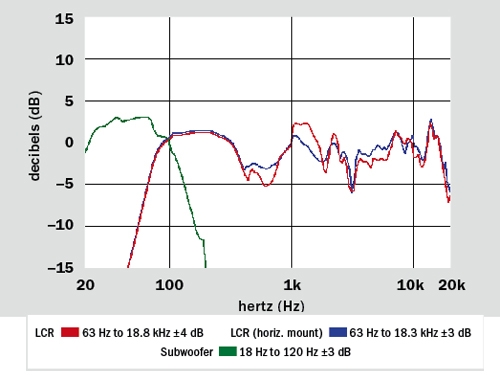MartinLogan Feature powered speaker and Abyss subwoofer Page 3
TEST BENCH

Frequency response (at 2 meters) Feature (vert. mount) 63 Hz to 18.8 kHz ±4.0 dB Feature (horiz. mount) 63 Hz to 18.3 kHz ±3.0 dB Feature (stand mount) 63 Hz to 20 kHz ±4.4 dB Abyss subwoofer 18 to 120 Hz ±3 dB Bass limits (lowest frequency and maximum SPL with limit of 10% distortion at 2 meters in a large room) Feature LCR: 40 Hz at 77.9 dB Abyss Subwoofer: 35.5 Hz at 79.8 dB 105 dB average SPL from 35.5 to 80 Hz 115.7 dB maximum SPL at 63 Hz Bandwidth uniformity 76%
All of the curves in the frequency-response graph are weighted to reflect how sound arrives at a listener's ears with normal speaker placement. Measurements were made at 2 meters to ensure that full effects of cabinet diffraction and front panel reflections were included. The Feature was measured mounted both vertically and horizontally on a large piece of plywood that mimicked the acoustical effect of a wall. It was also measured atop a 6-foot stand with its boundary switch in the Off-Wall setting. These tests gave quasi-anechoic results down to about 250 Hz. Response of woofers was close-miked, summed, and spliced to the quasi-anechoic response.
Given the Feature's exotic combination of drivers and its unusual shape, the frequency response is surprisingly smooth. No matter how the speaker was measured, it showed slight peaks centered at 3.1 kHz and 12.3 kHz, and a mild dip at 14 kHz. It also disperses sound fairly consistently whether it is mounted vertically or horizontally - quite an achievement when you consider the disparate dispersion characteristics of the various drivers employed in this design. Interestingly, in all positions, the response was actually smoother at 15º off-axis than it was on-axis. With the speaker mounted vertically, major response anomalies didn't occur until the measurement mike was moved at least 45º off-axis. With the speaker mounted horizontally, big dips at 3 kHz and 5 kHz show up at 30º off-axis.
(By the way, treble response in all modes extends above 20 kHz. The on-wall measurements are stated into the 18 -kHz range to provide a more relevant representation of the smoothness of the speaker's response. Anomalies above 18 kHz are not normally audible to adult ears.)
The On-Wall switch on the back of the Feature engages a filter to help lessen the acoustical effect of wall mounting. According to my measurements, it produces a -3 dB cut centered at 620 Hz. Matching between the two Feature samples I measured was good, deviating by 1.5 dB in a couple of very narrow frequency bands but generally staying within 0.5 dB. All of these measurements were taken through the line-level input; measurements made through the speaker-level inputs were essentially identical.
The impedance of the Feature runs higher than the 999-ohm maximum range of my lab equipment, because my equipment was designed to measure passive speakers, not active speakers such as the Feature. MartinLogan rates the impedance at the speaker terminals at 2,000 ohms; my measurement confirmed an impedance of 1,950 ohms at DC. Sensitivity measured 93.5 dB at 1 meter with a 2.83-volt signal at the speaker terminals. None of these measurements is important, though - the Feature's speaker-level input draws so little current that any audio amplifier can drive it.
Bass output of the Feature is excellent for an on-wall speaker; unless really powerful bass is demanded, it can deliver satisfyingly full sound without a subwoofer. At our bass output measurement threshold of 10% THD at 2 meters in a large room, the wall-mounted Feature averages 91 dB between 40 and 80 Hz, reaching a peak of 100.7 dB at 80 Hz. The speaker's useful bass extension is roughly 40 Hz, where it puts out 77.9 dB.
The Abyss appears to be designed for maximum output in the middle octave of bass, from 40 to 80 Hz. It delivers a maximum output of 115.7 dB at 63 Hz, which is impressive for such a small subwoofer. Maximum bass extension is 35.5 Hz, at which frequency output is 79.8 dB at 10% THD. Average SPL from 35.5 to 80 Hz is 105 dB. The close-miked response of the Abyss extends below 20 Hz, but the sub produces more than 10% THD at all signal levels at 30 Hz and below, so it's not effective in the bottom 2/3rd-octave of bass.













































